The document summarizes a study that used multidisciplinary design optimization to reduce the mass of a lightweight vehicle structure. The study optimized panel thicknesses and material grades to improve crash performance in frontal, side, and pole impacts as well as torsional rigidity. A radial basis function metamodel was used to approximate the vehicle responses during optimization to reduce computational cost. The initial vehicle model performance met crashworthiness targets but further mass reduction was possible through optimization.
![10
th
European LS-DYNA Conference 2015, Würzburg, Germany
© 2015 Copyright by DYNAmore GmbH
Multidisciplinary Design Optimisation Strategies for
Lightweight Vehicle Structures
Amit Prem
1
, Christophe Bastien
1
and Mike Dickison
2
1
Coventry University
Faculty of engineering and Computing
Coventry, CV1 5FB, UK
1 Introduction
The future of automobiles will be driven by lightweight structures and highly efficient powertrains. The
TARF-LCV EPSRC funded project (Towards Affordable, Closed-Loop Recyclable Future-Low Carbon
Vehicle Structures) [1] aims to provide a strong scientific and technological underpinning to future LCV
development in areas of advanced materials, low carbon manufacturing technologies, holistic mass-
optimised vehicle structure design and closed-loop recycling of end of life vehicles.
The initial work undertaken computed the ideal loadpath of the vehicle with the help of linear topology
optimisation [2]. From previous research, it was documented that the most realistic boundary
condictions to apply in the case of modelling crash events was Inertia Relief, in favour of standard
boundary conditions [3][4][5][6]. Inertia relief works by balancing the external loading with inertial
loads and accelerations within the structure itself. This is specifically done by "adding" an extra
displacement-dependent load to the load vector {F} in (1). Inertia relief has the benefit to prevent any
structural loadpath definition skewing, as in crash events the vehicle structure is in motion and not
physically restrained to its wheels.
(1)
The optimisation method utilised was based on a SIMP algorithm, which penalised the vehicle
structure design envelope Youngs Modulus, part of the stiffness matrix, leading to a vehicle mass
reduction (2). It was documented that a SIMP penalty factor p of 1 was adequate to obtain usefull
structural results [7].
The optimisation included a total of 6 individual loading scenarios including pole impact, side barrier
impact, roof crush, low speed centred rear impact, high speed rear impact and frontal impact: 40%
Offset Barrier. Linear topology results allowed some parts of the structure to be defined with credibility,
like the vehicle safety cell, whilst some other sections needed extra considerations, especially in the
areas prone to buckling [8][9].
Fig.1: Transfer of toplogy safety cell to a beam model [9].
p
k k (2)](https://image.slidesharecdn.com/9d936ee2-9f57-4d0b-9bdf-4bd9d2720d60-160606115334/75/Multidisciplinary-Design-Optimisation-Strategies-for-Lightweight-Vehicle-Structures_Final-1-2048.jpg)
![10
th
European LS-DYNA Conference 2015, Würzburg, Germany
© 2015 Copyright by DYNAmore GmbH
Linear solvers are not suitable to compute bifurcation [10][11], hence the vehicle front end and rear
end were re-engineered to meet controlled collapse mode, whilst the natural load obtained in the
linear topology optimsation was used to design body panels.
Fig.2: Interpretation of topology front end results to meet crash buckling mode
This re-engineering was based on 2 constraints. The first one being that the maximum loads
permitted, based on the beam model, stating that the front crash structure should not exceed 300kN at
the end of each front longitunals and the second being the force exerterd through the upper A pillar
being below its critical buckling load [9]. More automatic shape and size of body panels [12] routines
have been developed to convert the beam model cross section properties (second moment of area)
into closed sheet metal, constraining each Body In White (BIW) geometry to meet the vehicle exterior
styling [12].
The proposed model in this paper is the completion of the TARF vehicle architecture based on linear
optimisation. The optimisation methodology investigated in this paper will address the very local
structural changes which cannot be computed by a global topology and localised linear sizing
[13][14][15][16][17]. The paper will focus on a multi-disciplinary optimisation which will solelly include
size and material grades as the vehicle package is very well defined and no geometry modifications
can be performed.
2 Initial vehicle crash performance
The TARF vehicle has been modelled in LS-Dyna and will simultaneously address an optimisation
containing frontal ODB, side impact barrier, pole impact and torsional rigidity. In the original topology
work, torsional loadcase was not included, as the torsional load is very small compared to the
magnitude of the equivalent.
The LS-Dyna TARF model is a monocoque structure. The main loadpath structure has been meshed
at 5mm, whilst the door open panels (doors, boot, bonnet etc…) were discretized to 10mm and used a
variety of element types listed in Table 1.
Element types Beam Discrete Shell Solid
Number of
elements
2926 11 597621 84147
Table 1: Element type and count in the TARF LS-Dyna model
The total mass of the model is 1000kg (TARF project target mass), which is made of 163kg of the BIW
structure and 372kg for the ancillaries. Another 465kg of distributed nodal masses were added using
*Mass_Part to the model to include the masses of all other components, like seat, carpet, trim,
harness etc. Such that the whole structure attains its target mass. The total mass of the model would
vary during the study attributed to the change in panel thickness. The crash model has been solved
using the explicit solver with a timestep of 0.56µs leading to virtually no percentage added mass
during the whole duration of the computation.](https://image.slidesharecdn.com/9d936ee2-9f57-4d0b-9bdf-4bd9d2720d60-160606115334/75/Multidisciplinary-Design-Optimisation-Strategies-for-Lightweight-Vehicle-Structures_Final-2-2048.jpg)
![10
th
European LS-DYNA Conference 2015, Würzburg, Germany
© 2015 Copyright by DYNAmore GmbH
Fig.3: TARF model frontal and side impact setup
The impact velocities have been set as per table 2.
Scenarios Impact speed (m/s)
Front crash 17.9
Side impact 11.7
Pole impact 8.3
Table 2: Impact velocities for each safety loadcase
The impact velocity for the side impact is slightly lower due to the type of barrier being used weighing
1306kg instead of 950kg following Euro NCAP Side impact test Protocol v6.0 [18]. The side impact
velocity was computed so that the same kinetic energy is observed as per the protocol.
The energy plots depicted in Figure 4 confirm that the models are stable in all modes of impact. The
Total Energy equates to the sum of the Kinetic Energy and the Internal Energy (energy of
deformation), hence comply as a conservative system, as expected.
Fig.4: Energy balance validation of the crash models (front, side and pole impacts)
The fourth loadcase, torsional rigidity, has been computed using an implicit solver as the structure
does not need to plastically deform. Running this model in explicit would have caused some issues
with inertial effects, as to compute in a reasonable time, the torsional force would have needed to be
applied in 0.1s, which is not how a physical torsional test would be performed. This would have led to
structural oscillations, which would have masked the structural displacement needed to read the
torsional rigidity value.](https://image.slidesharecdn.com/9d936ee2-9f57-4d0b-9bdf-4bd9d2720d60-160606115334/75/Multidisciplinary-Design-Optimisation-Strategies-for-Lightweight-Vehicle-Structures_Final-3-2048.jpg)
![10
th
European LS-DYNA Conference 2015, Würzburg, Germany
© 2015 Copyright by DYNAmore GmbH
The torsional rigidity model is fundamentally the same as the crash models, except that the
*IMPLICIT cards were activated. The vehicle is clamped at the rear turrets and a force is applied at
the wheels centre via stiff spring, causing torsion. The torsional rigidity is measured by dividing the
cross section moment in the ‘X’ axis against the wheel angle change.
Fig.5: Torsional rigidity model setup
The structural performance of the TARF vehicle is assessed against the 4 loadcases. The study only
considered the structural integrity of the vehicle and did not consider the occupant’s injuries, the main
priority being to minimize structural mass and attain intrusion constraints within the cabin. For the front
ODB crash accelerometers are mounted on both the sill section below the B-Pillar to monitor the
deceleration pulse of the vehicle as per the Euro NCAP protocol for frontal ODB test [30]. The output
from the accelerometer is filtered using a SAE 60Hz filter. In order to monitor the intrusions, springs of
very low stiffness (0.1N.mm) in which their length will be monitored, as illustrated in Fig 6.
Fig.6: Location of sensors in TARF vehicle (Left: side and pole, Right: frontal measurements)
The springs across the occupant the H-point location monitor the structural deformation of the vehicle
in side and pole impact. The H-point location is chosen because it relates to the location of the
intrusion lined up with the occupant pelvis. The longitudinal springs capture the foot-well deformation
in frontal crash. The initial crash responses for different load cases are recorded in the following table.
The TARF-LCV structure performs relatively well in its current state. The vehicle structure however
consists of panels with estimated gauges and material allocation based on existing vehicle research
and through a number of design iterative methods which were manually undertaken and proved to be
time consuming. The main purpose of this study is to indicate the potential mass savings which can be
generated through optimized panel thickness and material grade allocation on the existing design.](https://image.slidesharecdn.com/9d936ee2-9f57-4d0b-9bdf-4bd9d2720d60-160606115334/75/Multidisciplinary-Design-Optimisation-Strategies-for-Lightweight-Vehicle-Structures_Final-4-2048.jpg)
![10
th
European LS-DYNA Conference 2015, Würzburg, Germany
© 2015 Copyright by DYNAmore GmbH
Scenarios Response Value Units
Frontal Crash
FC1_Intrusion 13.47 mm
FC2_Intrusion 26.37 mm
FC3_Intrusion 5.39 mm
FC_acceleration 445377.00 mm/s2
Pole Impact
PI1_Intrusion 47.76 mm
PI2_Intrusion 245.52 mm
PI3_Intrusion 275.52 mm
PI4_Intrusion 214.05 mm
Side Impact
SI1_Intrusion 1.37 mm
SI2_Intrusion 52.27 mm
SI3_Intrusion 165.00 mm
SI4_Intrusion 76.42 mm
Torsion Torsional_stiffness 9483970 Nmm/deg
Table 3: Initial response from TARF model
3 Methodology
The design of complex structures requires numerous computationally expensive simulations in order
to understand the responses for a particular loadcase. Metamodel based optimization can be
employed in order to minimize the computational time needed for design exploration where design
surfaces are fitted through points in the design space to construct an approximation to the design
response, the metamodel can then be used instead of actual simulations to find the optimum variables
[20].
Fig.7: Metamodel generation for a response depending on two design variables [19]
Each metamodel has its own unique properties as a result, a universal metamodel which performs
best for all possible problems does not exist. It is important to understand the problem at hand and try
to choose the best possible method. Another aspect to consider is whether the need of global
approximation which covers the entire design space is needed or if a local approximation model is
more appropriate. The complexity of the response which should be captured by the metamodel also
influences its selection. Noise would be another aspect to take into consideration, an approximating
model may perform better with the presence of noise, where as an interpolating model may not be the
right choice. Although the chances that an interpolating model would provide better predictions
compared to an approximating model in unknown points is not guaranteed even in the absence of
noise [19].
Metamodel comparative studies for multiple modeling criteria have been previously conducted and
according to one study [21] which compared Polynomial Regression (PR), Kriging, Multivariate](https://image.slidesharecdn.com/9d936ee2-9f57-4d0b-9bdf-4bd9d2720d60-160606115334/75/Multidisciplinary-Design-Optimisation-Strategies-for-Lightweight-Vehicle-Structures_Final-5-2048.jpg)
![10
th
European LS-DYNA Conference 2015, Würzburg, Germany
© 2015 Copyright by DYNAmore GmbH
Adaptive Regression Splines (MARS) and Radial Basis Functions (RBF) models, concluded that RBF
metamodel perform best overall and is the best model when small and scarce sample sets are used
when both average accuracy and robustness are taken into consideration. For very difficult problems
which were of large scale and of high-order nonlinearity, MARS model was found to be most accurate,
if large sample sets were used. The performance would however deteriorate if the sample size
reduces in which case RBF performs best. It was also found that Kriging is very sensitive to noise
since it interpolates the sample data. It is recommended that PR be used for low order nonlinearity
problems due to its high accuracy and ease of use. PR is however not accurate for highly nonlinear
problems. The authors who conducted the study have proposed that PR be implemented first to see if
a reasonable fit can be obtained. However studies [22] have shown that Support Vector Regression
(SVR) had the best performance overall when accuracy and robustness are taken into consideration.
More recent studies [23] also indicate that SVR performed best in terms of prediction accuracy and
robustness for stochastic problems, the next best model was found to be Kriging. The models that
were compared includes artificial neural network, RBF, Kriging, SVR and MARS. Although there has
been contradicting studies [24] which concluded that Kriging and Moving Least Squares (MLS)
provided accurate metamodels when compared to SVR and RBF models, hence it is not possible to
come to a clear conclusion on which metamodel performs best overall as there are a number of
parameters that can be tuned while building a metamodel and the results can vary considerably based
on how well these parameters have been tuned, the software used also influences the results. The
main concept would be to use several metamodels to perform optimization continuously which would
lead to the best design possible [19]. Multidisciplinary design optimization is a process where multiple
disciplines such as Crash, NVH or Torsional Rigidity are included within the optimization. This allows
the optimization process to consider different loadcases and find an optimum which meets all of the
constraints established while adhering to the optimization objective.
3.1 Polynomial Response Surface Methodology
Polynomial metamodels are also known as response surface models and is used in response surface
methodology (RSM). The RSM has been defined as a set of statistical and mathematical methods for
developing, improving and optimizing processes and products [19]. The models are developed by a
process of fitting a regression model to a dataset of variable settings and corresponding responses.
The polynomial terms is recommended to be used for the screening process of the variables and for
the cross-influence of the variables when responses are being determined [20]. When sequential
response surface method is used which is an iterative process of finding the optimum variables,
polynomial response surface methodology is commonly utilized mainly due to cost [29].
3.2 Radial Basis Functions (RBF)
A Radial basis function methods are the means to approximate the multivariate function [25]. The
method uses linear combinations of a radially symmetric function based on Euclidean distance or
other such metric to approximate response functions [21]. The Radial Basis neural network consists of
a 3-layer topology of which the input layer is linear, the hidden layer is made up of non-linear radial
units each of which responds to only a local region of input space and the output layer creates an
approximation over the entire design space through input-output mapping after performing a biased
weighted sum of these units. Some of the basic functions commonly used are Hardy’s multiquadrics
functions and the Gaussian function [26].
Hardy’s Multi-quadric:
(3)
Guassian:
(4)](https://image.slidesharecdn.com/9d936ee2-9f57-4d0b-9bdf-4bd9d2720d60-160606115334/75/Multidisciplinary-Design-Optimisation-Strategies-for-Lightweight-Vehicle-Structures_Final-6-2048.jpg)
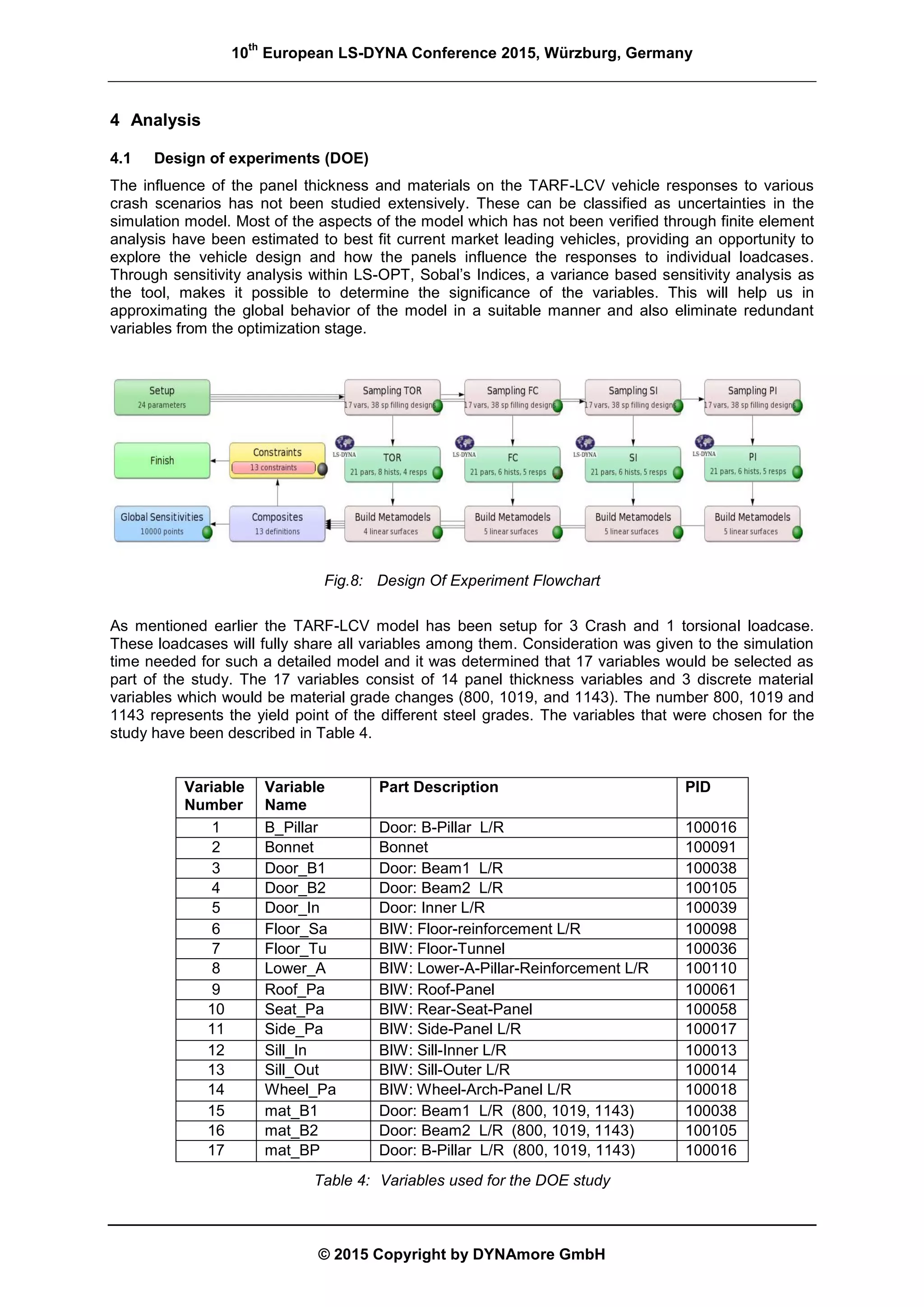
![10
th
European LS-DYNA Conference 2015, Würzburg, Germany
© 2015 Copyright by DYNAmore GmbH
Fig.9: Red colour indicates variable locations on the model
The responses to be monitored are the vehicle mass, intrusion and acceleration for the frontal offset
crash and passenger compartment intrusion measurements for the Side and Pole impact and
calculated Torsional stiffness value for the Torsional loadcase.
A Polynomial metamodel of linear approximation order was considered for the DOE study, Although
D-optimum sampling method is recommended for polynomial metamodel, Space filling sampling
method was employed for the point distribution over the design space. Space filling algorithm tends to
maximize the minimum distance between the experimental design points for a given number of points
[20]. The default set of simulation points for 17 variables was generated as 28, however 38 simulation
points were considered for the analysis. The constraints were setup as follows for the crash models.
Constraints Upper Bound Constraints Upper Bound
FC1_Intrusion 20 mm PI3_Intrusion 349 mm
FC2_Intrusion 30 mm PI4_Intrusion 318 mm
FC3_Intrusion 20 mm SI1_Intrusion 20 mm
FC_acceleration 480000 mm/s2
or 48.9g SI2_Intrusion 145 mm
PI1_Intrusion 151 mm SI3_Intrusion 232 mm
PI2_Intrusion 320 mm SI4_Intrusion 150 mm
Table 5: Constraints for the DOE of crash models
The torsional model was setup with a lower bound of 8.8 kNm/deg or 8800000 Nmm/deg. The
constraints were obtained by taking the average value through bench marking studies conducted on
existing vehicles for the side and pole impact. The constraints for the front passenger compartment
footwell intrusion levels are considerably lower than the limit established by Euro NCAP frontal offset
test. There has been considerable research over the years suggesting footwell intrusion and pedal
movements result in significant injuries to the lower legs of the occupants. A study from 2003 by
NHTSA [27] which was based on crash result data from approximately 58,000 non-vehicle nearside
occupant injuries and 62,000 vehicle nearside occupant injuries indicate that many moderate and
maximum injuries take place with occupant compartment intrusions less than 150 mm. The study also
looked into the injury severity, AIS 2+ and AIS 3+ injuries were also reported for intrusion levels
greater than or equal to 30mm. It must also be noted that the fleet in consideration was non-uniform in
nature and factors such as age and seat belt use was not taken into account.](https://image.slidesharecdn.com/9d936ee2-9f57-4d0b-9bdf-4bd9d2720d60-160606115334/75/Multidisciplinary-Design-Optimisation-Strategies-for-Lightweight-Vehicle-Structures_Final-8-2048.jpg)
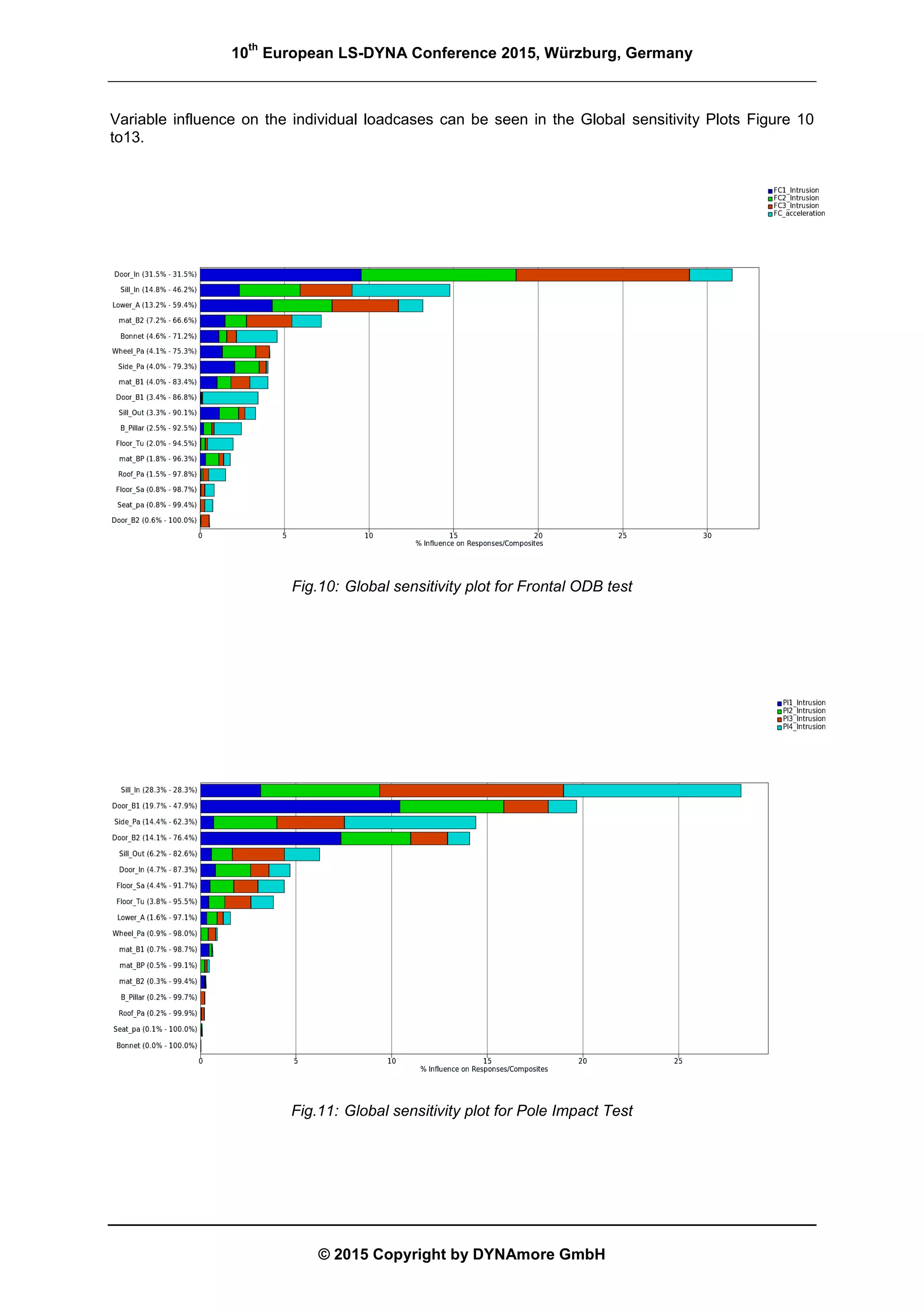
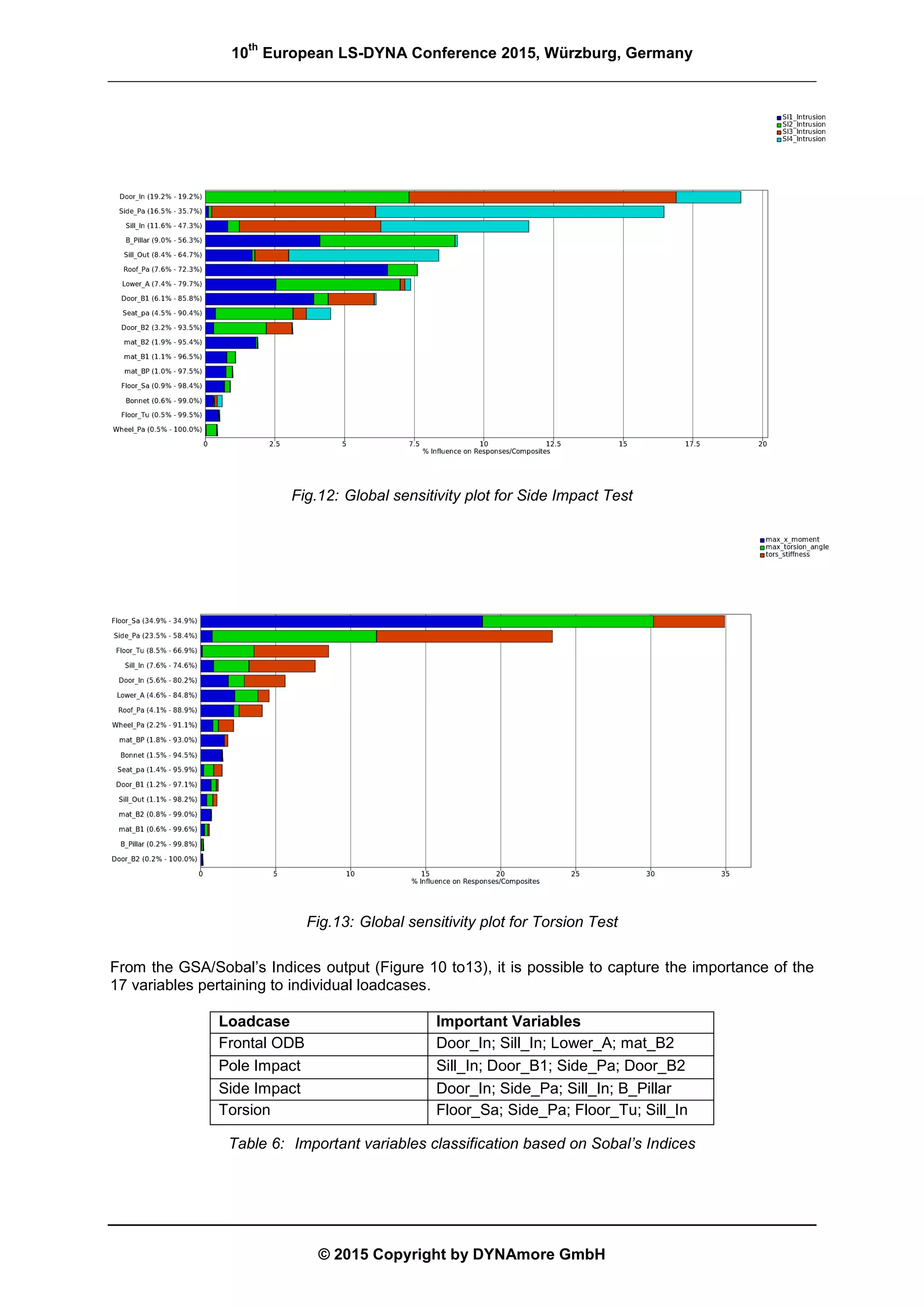
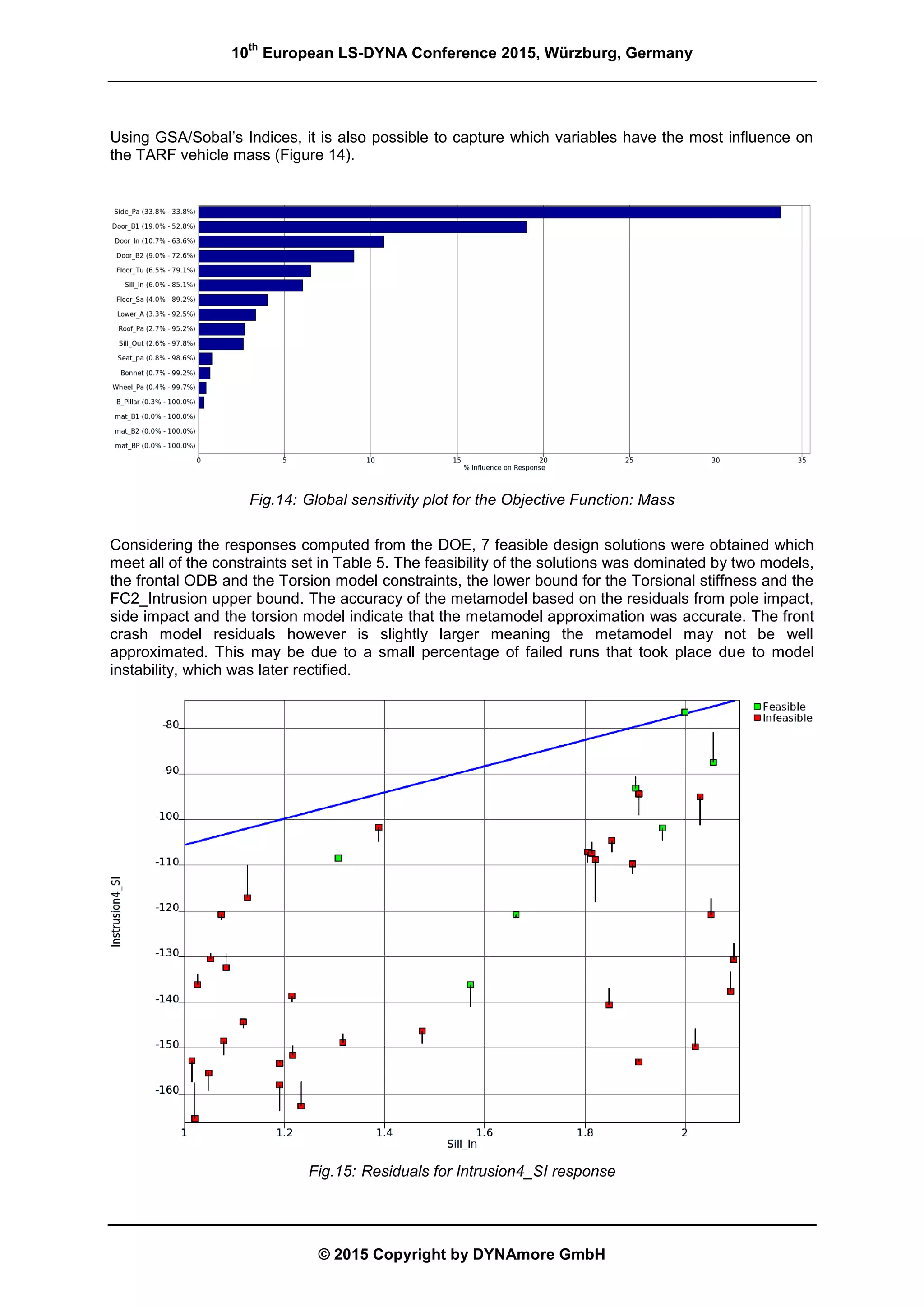
![10
th
European LS-DYNA Conference 2015, Würzburg, Germany
© 2015 Copyright by DYNAmore GmbH
Fig.16: Structural mass reduction potential from DOE simulation points
From the DOE study, it is possible to identify the potential mass savings for the TARF vehicle structure
(Figure 16). The percentage reduction is directly associated with the sum of the chosen variables
component mass reduction due to the change in panel thickness. Along with the baseline run,
simulation points 1.3, 1.7, 1.13, 1.27, 1.31 and 1.35 were the only feasible options available. Certain
variable values from run 1.31 would be considered for the optimization study as starting variables.
Although not the optimum values they provide a better estimate than previously considered. The
negative effects of this would however be reflected on the torsional performance of the model. Due to
which the lower bound on the torsion model would be revised for the optimization study.
4.2 Structural Optimization: Single stage optimization method
This method is ideal when there is a limited simulation budget and is used in this study to identify the
potential optimum variables. Single stage optimization method along with sequential is considered
good for design exploration. However in order to employ this method in MDO for automotive
application, metamodels which can capture complex responses and predict accurately with flexible
sample sets are required. RBF using Hardy’s Multi-Quadrics transfer function was considered as the
metamodel for this study along with space filling as the sampling method, space filling was again
taken into account because the space filling algorithm does the positioning of all the points in a single
cycle [20]. Since a global optimization is being undertaken there is a need to choose the right
algorithm. Within LS-OPT we have a number of global stochastic optimization algorithms such as
Genetic algorithm (GA), Adaptive simulated annealing (ASA) and a combination of global optimizers
with local gradient based optimization method known as Hybrid algorithm. The Hybrid algorithms are
better suited for global optimization for being both efficient and effective. ASA with Leapfrog optimizer
for constrained minimization (LFOPC) was chosen as the algorithm for the optimization stage.
Fig.17: Optimization Flowchart](https://image.slidesharecdn.com/9d936ee2-9f57-4d0b-9bdf-4bd9d2720d60-160606115334/75/Multidisciplinary-Design-Optimisation-Strategies-for-Lightweight-Vehicle-Structures_Final-12-2048.jpg)
![10
th
European LS-DYNA Conference 2015, Würzburg, Germany
© 2015 Copyright by DYNAmore GmbH
From the DOE study dominant variables were established for individual loadcases and its significance
on the mass of the vehicle structure. Variable no 1, 3, 4, 5, 8, 11, 12 and 17 from table 4 were
considered for the optimization stage, comprising of 7 panel thickness variables and 1 discrete
material variable. All the other variables with significant influence on individual responses were not
considered for the optimization phase. The main influential variables for the torsion models were kept
constant and assigned values from run 1.31 of the DOE. The torsion model lower bound was thus
further reduced. The upper bound of Intrusion 2 for the frontal ODB was increased by 10mm. The
main objective of the optimization is to minimize the mass, these changes were brought about to
explore if significant mass reductions could be expected at the expense of torsional stiffness and
passenger compartment intrusion for the frontal ODB, the changes to the passenger compartment
intrusion is still within reason. Since the starting values for the variables are different from that of the
initial baseline model there maybe adverse effects that also needs to be taken into consideration. The
rest of the constraints remained unchanged.
The single stage optimization method used a much larger number of simulation points for each
loadcase compared to the DOE to improve metamodel accuracy. The 8 chosen variables were fully
shared, previous studies have indicated that partially sharing variables based on elimination of
variables using sensitivity plots, results in a faster convergence for other optimization methods such as
sequential [28]. The resource allocation is an important aspect when computational costs and time are
concerned, the torsion model due to its implicit nature is not very time consuming to run but requires a
large amount of memory because of the use of double precision. Crash simulations are explicit in
nature and is usually time consuming but require less memory. It would be ideal to assign large
number of processors to crash simulation models. The average time needed to run the TARF-LCV
crash model was 9 hours on 16 processors. Total of 448 processors were used for the optimization
study. The global sensitivity plot from the optimization study is depicted in the following image and
shows the influence of the variables on the Individual responses.
Fig.18: Global sensitivity plot from the optimization stage
The Sill inner panel is found to be the most influential on the vehicle responses, this was noted during
the DOE as well. The sill is predominantly a larger section on the TARF vehicle structure and the
single large door inner design with integrated B-pillar influences the crash response of the vehicle. The
B-pillar and its material grade change had the least influence on the response which validates the
findings from the DOE. The optimum Torsional stiffness and the FC2_Intrusion values found through
the optimization phase are given in the following Figure 19.](https://image.slidesharecdn.com/9d936ee2-9f57-4d0b-9bdf-4bd9d2720d60-160606115334/75/Multidisciplinary-Design-Optimisation-Strategies-for-Lightweight-Vehicle-Structures_Final-13-2048.jpg)
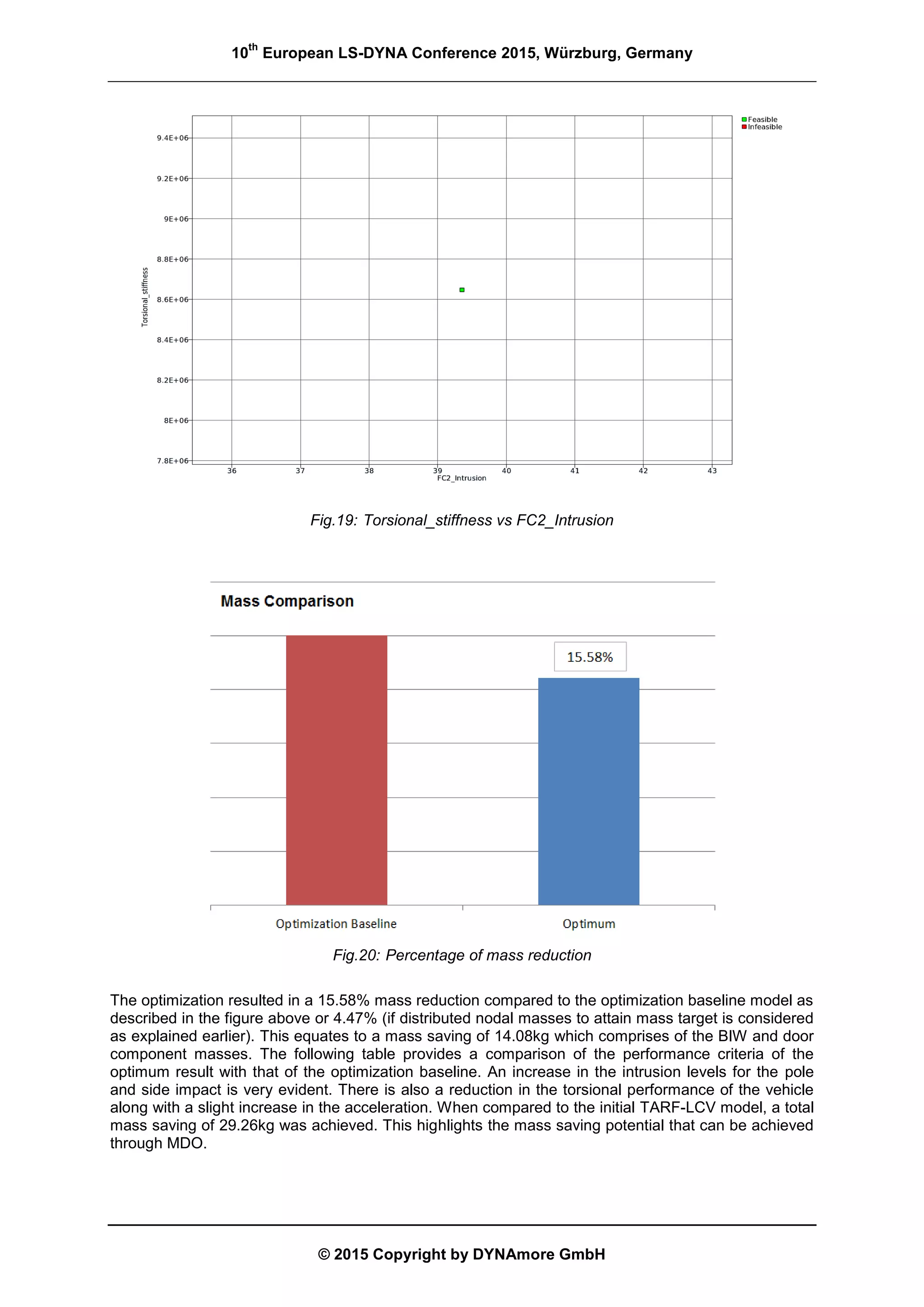
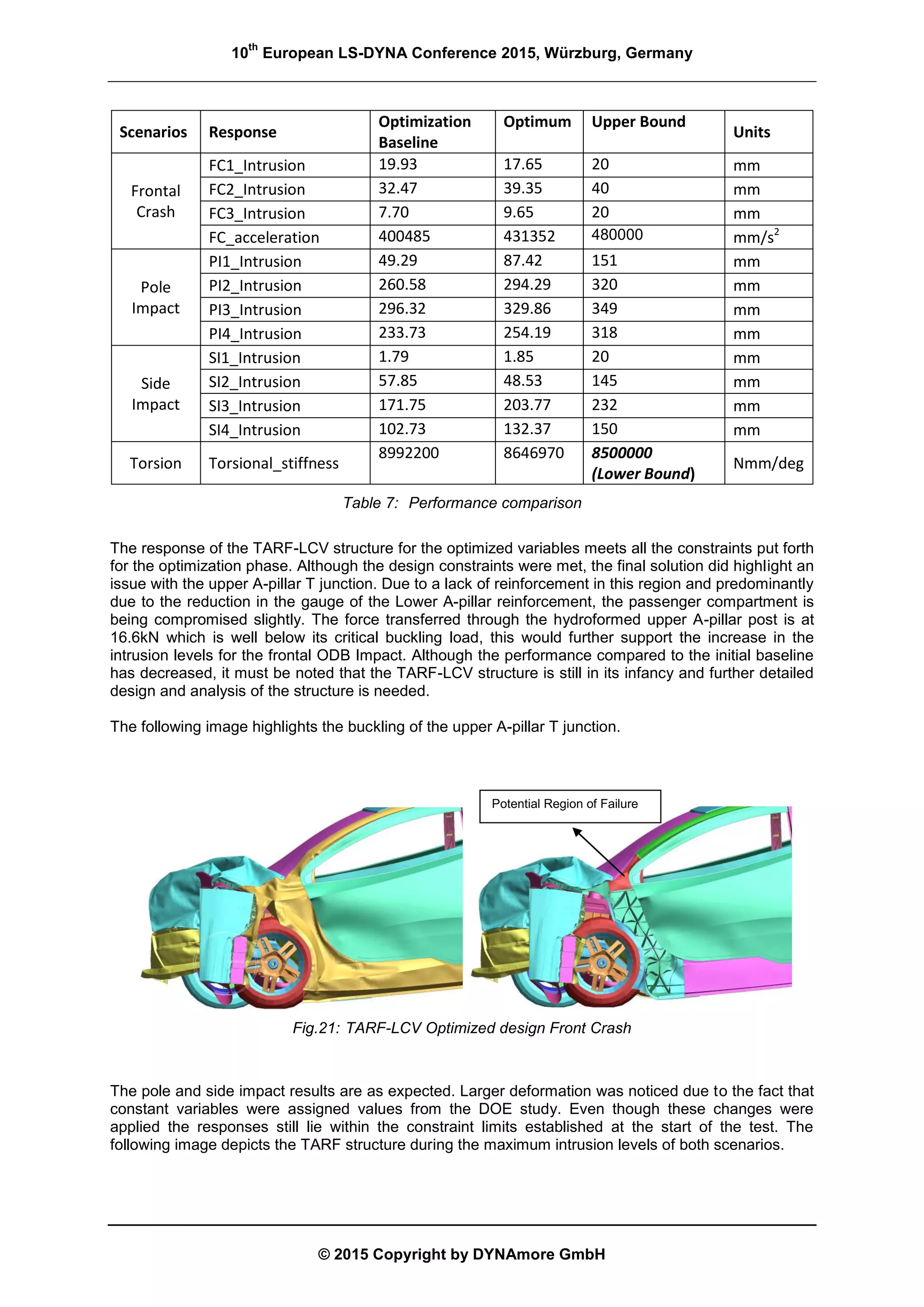
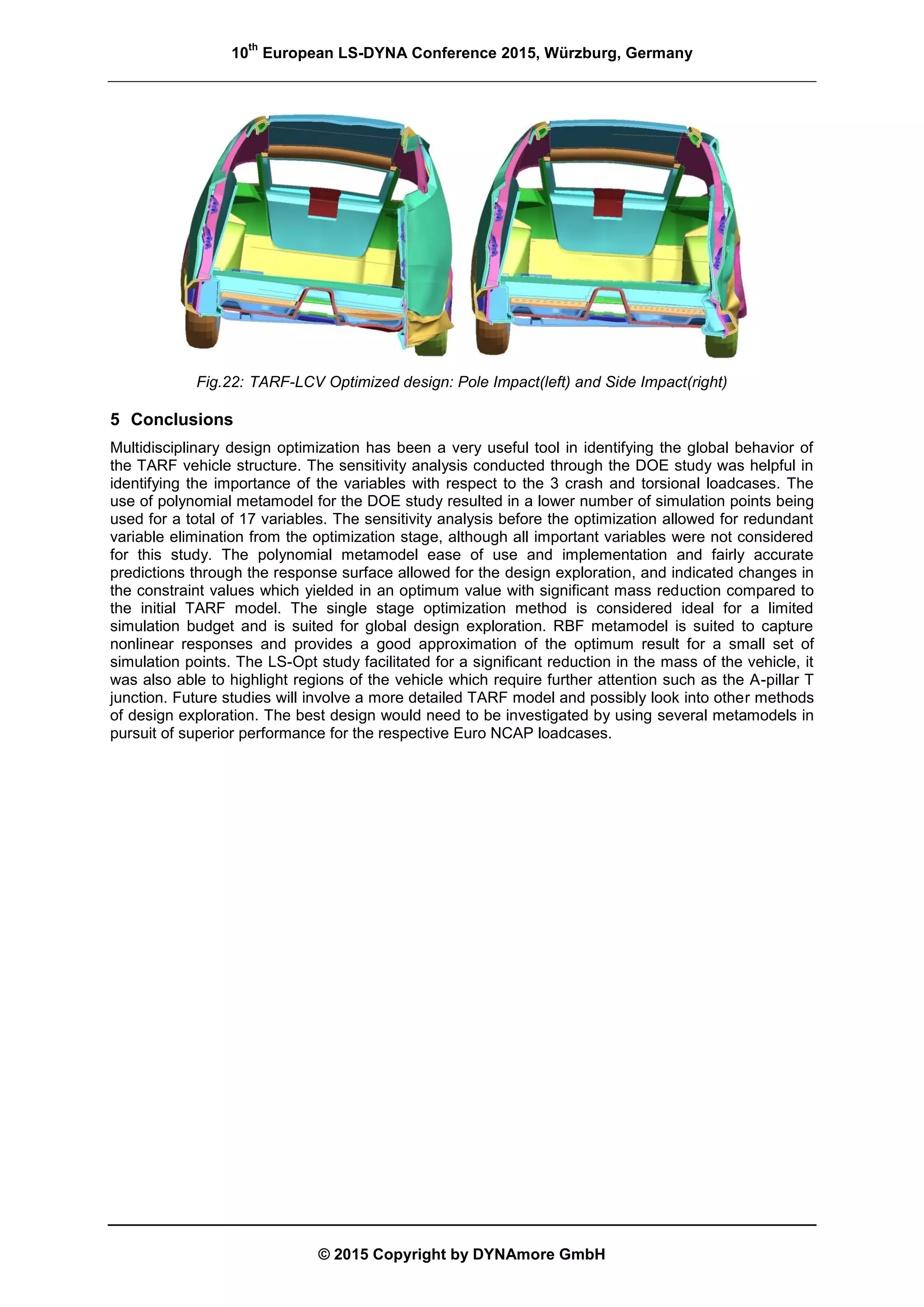
![10
th
European LS-DYNA Conference 2015, Würzburg, Germany
© 2015 Copyright by DYNAmore GmbH
Literature
[1] TARF, Towards Affordable Closed-Loop Recyclable Future-Low Carbon Vehicle Structures (2011)
EPRSC funded project. http://gow.epsrc.ac.uk/NGBOViewGrant.aspx?GrantRef=EP/I038616/1
[2] LCVTP (2011), Low Carbon Vehicle Technology Project. Re: BG/AM1011, partly funded by ERDF
and AWM. Project based on Tata ‘Beacon’ vehicle layout. Participation of Coventry University for
vehicle aerodynamics, HVAC and Vehicle Body Structure
[3] Bastien, C. (2010) “Topology Optimisation of a Body In White for Low Carbon Vehicle Technology
Project”, Altair European conference, EHTC 2010, October 2010, Versailles, France
[4] Bastien, C., Christensen, J. (2011) 'Towards the Light weighting of Low Carbon Vehicle
Architectures using Topology Optimisation', EHTC November 2011, Bonn, Germany
[5] Christensen, J., Bastien, C., Blundell, M. V., Gittens, A., Tomlin, O. (2011) "Lightweight Hybrid
Electrical Vehicle Structural Topology Optimisation Investigation Focusing on Crashworthiness",
International Journal of Vehicle Structures and Systems, Volume 3, Issue 2.
[6] Christensen, J., Bastien, C., Blundell, M.V., Kurakins, J., (2012) “Lightweight body in white design
using topology-, shape and size optimisation”, Electric Vehicle Symposium (EVS26), Los Angeles,
California, 2012.
[7] Christensen, J., Bastien, C. (2011a) 'Effects of Roof Crush Loading Scenario Upon Body In White
Using Topology Optimisation', C, J., ICRASH Journal, December 2011.
[8] Christensen, J., Bastien, C., Grimes, O., Appella, A., Bareham, G., O’Sullivan, K. (2011b)
“Generation of Optimised Hybrid Electric Vehicle Body In White Architecture from a Styling Envelope”
[9] Prem, A., Bastien, C. (2013) “Optimisation of Future Lightweight Multi-material Vehicle Crash
Structures”. Proceeding of the IMechE conference held in Gaydon on 13th December 2013
[10] Soto, C. A, (2004) “Structural topology optimization for crashworthiness”. Int. J. Vehicle Structures
& Systems, Volume 9, issue 3, pages 277-283.
[11] Du Bois, P. (2010) ‘Crashworthiness and Impact Engineering with LS-Dyna’. Engineering Course
Notes, California, Livermore Software Technology Corporation
[12] Christensen, J., Bastien, C., and Blundell, M. (2013) 'Buckling Considerations and Cross-
Sectional Geometry Development for Topology Optimised Body In White'. International Journal of
Crashworthiness 18 (4), 319-330. Available from http://dx.doi.org/10.1080/13588265.2013.792442
[13] Duddeck, F., (2007) “Multidisciplinary optimization of car bodies”. Technical paper. Available
online <www.springerlink.com/content/2741p87038110l7>. London, UK.
[14] Horstmeyer, M.F., Ren, X.C., Fang, H., Acar, E., Wang, P. T. (2009) “A comparative study of
design optimisation methodologies for side-impact crashworthiness, using injury-based versus energy-
based criterion”. Int. J. Vehicle Structures & Systems, Volume 14, issue 2, pages 125-138.
[15] Liao, X., Li, Q., Yang, X., Li, W., Zhang, W. (2008) “A two-stage multi-objective optimisation of
vehicle crashworthiness under frontal impact”. Int. J. Vehicl Structures & Systems, Volume 13, issue 3,
pages 279-288.
[16] Marur, P. R., Srinivas, S, (2008). “A reduced-order finite element model for the simulation of
automotive side structure crash response. Int. J. Vehicle Structures & Systems, Volume 13, issue 2,
pages 211-218.](https://image.slidesharecdn.com/9d936ee2-9f57-4d0b-9bdf-4bd9d2720d60-160606115334/75/Multidisciplinary-Design-Optimisation-Strategies-for-Lightweight-Vehicle-Structures_Final-17-2048.jpg)
![10
th
European LS-DYNA Conference 2015, Würzburg, Germany
© 2015 Copyright by DYNAmore GmbH
[17] Zimmer, H., Prabhuwaingankar, M., Duddeck, F. (2009) “Topology & Geometry Based Structure
Optimization using implicit Parametric Models and LS-OPT”. Technical paper. Available online
<www.dynalook.com/european-conf-2009/F-II-02.pdf>.
[18] European New Car Assessment Programme: Euro NCAP (2012) Side Impact Testing Protocol
V6.0 Available from www.euroncap.com/en/for-engineers/protocols/adult-occupant-protection/
[19] Ryberg, A.B., Bäckryd, R.D., Nilsson, L.: (2012) “Meamodel-Based Multidisciplinary Design
Optimization for Automotive Applications”, Linköping University, Technical Report.
[20] Stander, N.,Roux W.,Basudhar A.,Effleston T.,Goel T.,Craig K. “LS-OPT User’s Manual, Version
5.0”. Livermore Software Technology Corporation, California, USA, April 2013.
[21] Jin, R.,Chen, W., Simpson, T. (2001). “Comparative Studies of metamodelling techniques under
multiple modelling criteria”. Structural and Multidisciplinary Optimization, 23(1), 1-13.
[22] Clarke, S.M., Griebsch, J.H., Simpson, T.W. (2005). “Analysis of support vector regression for
approximation of complex engineering analysis”. Journal of Mechanical Design, 127(6), 1077-1087.
[23] Li, Y., Ng, S., Xie, M., Goh, T. (2010). “A systematic comparison of metamodeling techniques for
simulation optimization in decision support systems”. Applied Soft Computing, 10(4), 1257-1273.
[24] Kim, B.-S., Lee, Y.-B., Choi, D.-H. (2009). “Comparison study on the accuracy of metamodeling
technique for non-convex functions”. Journal of Mechanical Science and Technology, 23(4),1175-
1181.
[25] Martin, D.B., Ciarlet, P.G., Iserles A., Kohn R.V., Wright M.H. (2003). “Radial Basis Functions
theory and Implementations”. Cambridge University Press, 271.
[26] Stander, N., Goel, T. (2008). “Metamodel Sensitivity to sequential adaptive sampling in
crashworthiness design”. 10th International LS-DYNA User’s Conference.
[27] Eigen, A.M., Glassbrenner, D. (2003). “The relationship between occupant compartment
deformation and occupant injury”. NHTSA Technical Report, 37.
[28] Craig, K.J., Stander, N., Dooge, D.A., Varadappa S. (2002). “Multidisciplinary Design
Optimization of automotive crashworthiness and NVH using LS-OPT”. Proceedings from 7th
International Ls-dyna User’s Conference.
[29] Stander, N., Roux, W.J., Giger, M., Redhe, M., Fedorova, N., Haarhoff, J. (2003).
“Crashworthiness Optimization in LS-OPT: Case Studies in Metamodeling and Random Search
Techniques”. Proceedings from 4th European LS-DYNA Conference, Ulm, Germany.
[30] European New Car Assessment Programme: “Euro NCAP (2012) Frontal Impact Testing Protocol
V6.0” Available from www.euroncap.com/en/for-engineers/protocols/adult-occupant-protection/](https://image.slidesharecdn.com/9d936ee2-9f57-4d0b-9bdf-4bd9d2720d60-160606115334/75/Multidisciplinary-Design-Optimisation-Strategies-for-Lightweight-Vehicle-Structures_Final-18-2048.jpg)